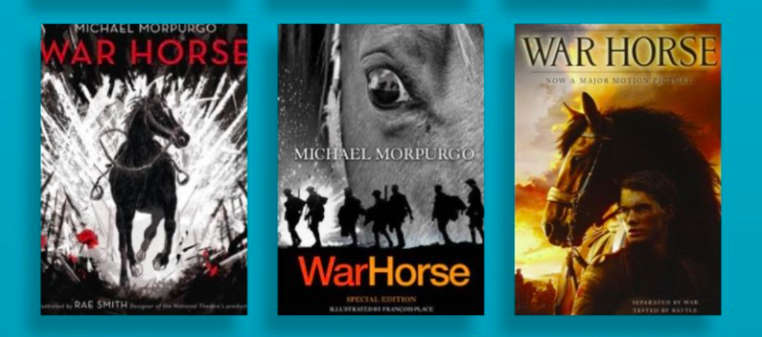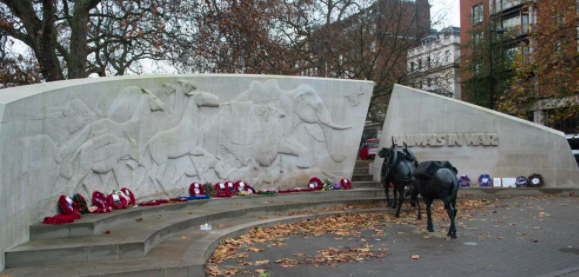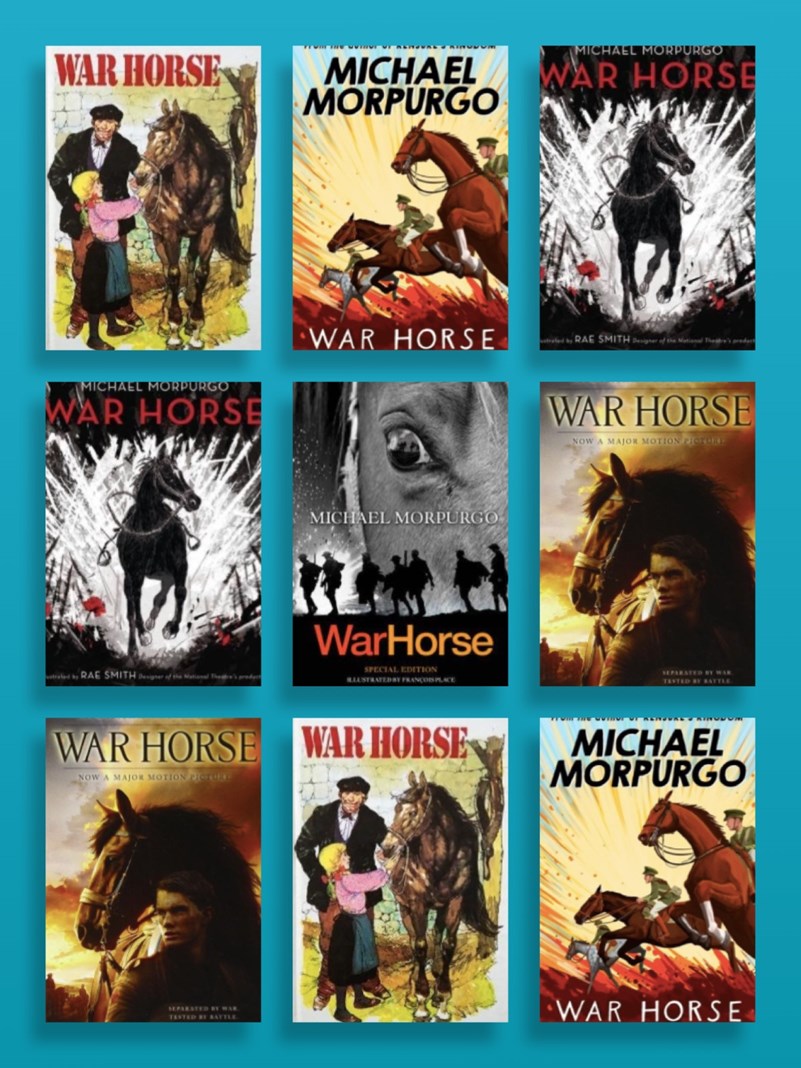The Roles Animals Played in the First World War Competition
- Home
- Latest News
- 2021
- June 2021
- The Roles Animals Played in the First World War Competition

This year’s Western Front Association 'Project with Prizes' asks 12-14 year old secondary school students to think about the roles animals played in the First World War. Using examples from Michael Morpurgo’s War Horse as their starting point, students are invited to submit either:
1) One or two passages in which an animal describes their wartime experiences (up to 500 words total) or
2) A cover for a new book about an animal in the First World War. It will need to have a title and author and students may, if they wish, include the back of the cover with a short 'blurb' about the story they are illustrating.
This project is designed to build on other work students have done about the First World War and to take one lesson and one homework although they may, of course, want to spend longer on their pieces of writing or art or their own research. Materials you and they can draw upon are included here.
Completed projects: emailed to:education@westernfrontassociation.com
Deadline: 5 November 2021
The pieces of work we find most interesting will receive books and a certificate of commendation. By entering, students agree that we can name them and publish their work on our website and in our magazine.
Animals in the First World War

Animals in War, Hyde Park Memorial
Hyde Park in London is home to a very unusual war memorial. There is a semi-circle of white stone broken with a gap in the middle through which a heavily loaded horse and mule trudge wearily. To the left of them the wall is carved with the figures of animals: camels, dogs, elephants, goats, more horses and donkeys, a cat, pigeons and even glow worms. On the right side there is an inscription:
|
Animals in War This memorial is dedicated to all the animals that served and died alongside British and Allied Forces in wars and campaigns throughout time. They had no choice. |
On the other side of the memorial, a horse and a dog have come through the gap and run away, free. Silhouettes of the animals are carved into the long side of the memorial – perhaps they are free now – and there is another inscription:
|
Many and various animals were employed to support British and Allied Forces in wars and campaigns over the centuries, and as a result million died. They all played a vital role in every region of the world in the cause of human freedom. Their contribution must never be forgotten. |
A short video of a visit to the Animal War Memorial can be seen here:
Joey’s Story
Many of you will already be familiar with Michael Morpurgo’s book War Horse which tells the story of Joey a much-loved part-thoroughbred horse who is sold to a cavalry officer in 1914 and sent to France. He survives terrible events on the battlefields: riding into battle, pulling ambulances and guns, meeting tanks and barbed wire, belonging to British, French and German people, he does not know why he is there, or about the different sides, he understands only that he is treated sometimes with kindness and humanity and sometimes cruelly.
The story is told from the point of view of Joey himself. Here are two passages from the book in which he describes his experiences.
Extract 1
Joey has been bought by a cavalry officer, Captain Nicholls, and taken from the farm in Devon where he lived to the Western Front, in France. He has become friends with another cavalry officer’s horse, Topthorn. This extract describes his first experience of battle.
'I felt Captain Nicholls’ knees close right around me and he loosened the reins. His body was taut and for the first time he felt heavy on my back. "Easy Joey," he said softly. "Easy now. Don’t get excited. We’ll come out of this all right, don’t you worry."
I turned to look at Topthorn who was already up on his toes ready for the trot that we knew was to come. I moved instinctively closer to him and then as the bugle sounded we charged out of the shade of the wood and into the sunlight of battle.
The gentle squeak of leather, the jingling harness and the noise of hastily barked orders were drowned now by the pounding of hooves and the shout of the troopers as we galloped down on the enemy in the valley below us. Out of the corner of my eye, I was aware of the glint of Captain Nicholl’s heavy sword. I felt his spurs in my side and I heard his battle cry. I saw the grey soldiers ahead of us raise their rifles and heard the death rattle of a machine-gun, and then quite suddenly I found that I had no weight on my back any more and that I was alone out in front of the squadron. Topthorn was no longer beside me, but with horses behind me I knew there was only one way to gallop and that was forward. Blind terror drove me on, with my flying stirrups whipping me into a frenzy. With no rider to carry I reached the kneeling riflemen first and they scattered as I came upon them.
I ran on until I found myself alone and away from the noise of the battle, and I would never have stopped at all had I not found Topthorn once more beside me with Captain Stewart leaning over to gather up my reins before leading me back to the battlefield. We had won, I heard it said; but horses lay dead and dying everywhere…
…I never saw Captain Nicholls again and that was a great and terrible sadness for me for he had been a kind and gentle man and had cared for me well as he had promised. As I was to learn, there were few enough such good men in the world.'
Extract 2
Joey and Topthorn’s cavalry riders are taken prisoner and the Germans put the two horses to work pulling ambulance carts. At night they are stabled with a French farmer and his granddaughter who loves them and cares for them. Eventually this interlude comes to an end when they are taken to join a gun team by a German artillery troop hauling a heavy gun through the mud across the battlefield. The work is hard, the weather cold and wet, the horses are no longer stabled and food is scarce.
'I first noticed that Topthorn was failing when I felt the gun pulling more heavily than before. We were fording a small stream when the wheels of the gun became stuck in the mud. I turned quickly to look at him and saw him labouring and low in his stride. His eyes told me the pain he was suffering and I pulled all the harder to enable him to ease up.
That night with the rain sleeting down relentlessly on our backs I stood over him as he lay down in the mud. He lay not on his stomach as he always did, but stretched out on his side, lifting his head from time to time as spasms of coughing shook him. He coughed intermittently all night and slept only fitfully. I worried over him nuzzling him and licking him to try to keep him warm and to reassure him that he was not alone in his pain. I consoled myself with the thought that no horse I had ever seen had the power and stamina of Topthorn and that he must have a reservoir of great strength to fall back on in his sickness.
And sure enough he was up on his feet the next morning before the gunners came to feed us our ration of corn, and although his head hung lower than usual and he moved ponderously, I could see that he had the strength to survive if only he could rest.
I noticed however that when the vet came that day checking along the lines, he looked long and hard at Topthorn and listened carefully to his chest. "He’s a strong one," I heard him tell the spectacled officer – a man whom no one liked, neither horses not men. "There’s fine breeding here, too fine perhaps Herr Major, could well be his undoing. He’s too fine to pull a gun. I’d pull him out but you have no horse to take his place, have you? He’ll go on I suppose, but go easy on him, Herr Major. Take the team as slow as you can, else you’ll have no team, and without your team your gun won’t be a lot of use to us, will it?"
"He will have to do what the others do, Herr Doctor," said the major in a steely voice. "No more and no less. I cannot make exceptions. If you pass him fit, he’s fit and that’s that."
"He’s fit to go on," said the vet reluctantly. "But I am warning you Herr Major. You must take care."
"We do what we can," said the major dismissively. And to be fair they did. It was the mud that was killing us one by one, the mud, the lack of shelter and the lack of food.'
The Art of 'War Horse'
War Horse has been published many times and several artists have designed covers for it. Here are some examples of those covers:

Extracts and Covers used here by kind permission of Egmont/HarperCollins publishers.
Other Animals that went to War
Horses were not the only animals that were put to work in the First World War. The Imperial War museum tells us that:
'Over 15 million animals went to war. They were used for transport, communication and companionship.
In 1914, both sides had large cavalry forces. Horse and camel-mounted troops were used in the desert campaigns throughout the war, but on the Western Front, new weapons like the machine gun made cavalry charges increasingly difficult.
However, animals remained a crucial part of the war effort. Horses, donkeys, mules and camels carried food, water, ammunition and medical supplies to men at the front, and dogs and pigeons carried messages. Canaries were used to detect poisonous gas, and cats and dogs were trained to hunt rats in the trenches.
Animals were not only used for work. Dogs, cats, and more unusual animals including monkeys, bears and lions, were kept as pets and mascots to raise morale and provide comfort amidst the hardships of war.'
You can see pictures and read about some of these animals here:
15 Animals that went to war (IWM History)
The central animal for your book could be a:
- Mule
- Dog
- Camel
- Elephant
- Pigeon
- Cat
- Canary
- Glow Worm (Yes, really. They were kept in jars and used as torches so soldiers could read trench maps at night.)
- or any other animal that your own research tells you went to the First World War
Your book can be set anywhere that the war took place: so, not only in France or Belgium but also in Turkey or the Middle East. Your animal can be attached to the army, the navy or the air force and they can be working for any of the countries involved in the war.
Other Useful Links
- How Did Animals Help in World War One – BBC Bitesize (text, pictures, cartoon and film)
- The Role of Animals in World War One – BBC Newsround
- Animals that went to War – YouTube video from Imperial War Museum (N.B. This covers wars from the past 100 years so that not all of it is relevant to the First World War.)
- 12 Ways Animals Have Helped the War Effort - IWM (includes Second World War so be careful to refer only to First World War!)
- Voices of the First World War – Animals in War (IWM Podcast using archive recordings)
- Animals in the Great War – Western Front Association Podcast based on the book of the same name by Lucinda Moore





